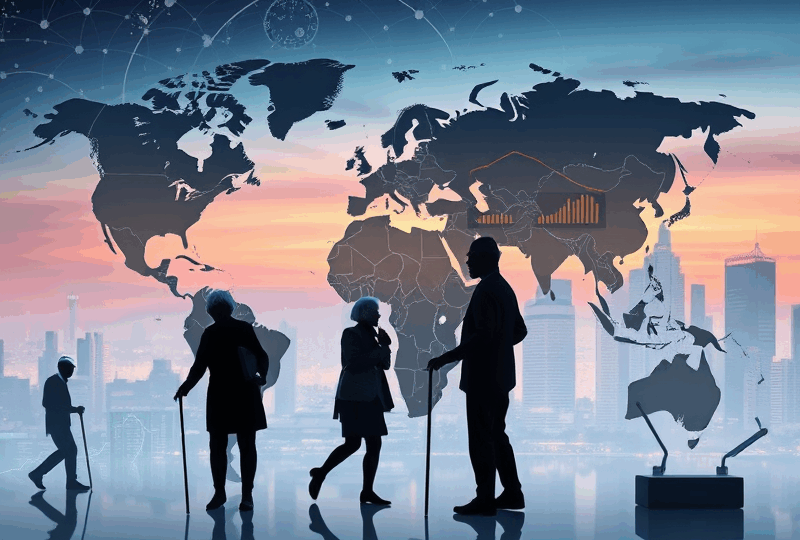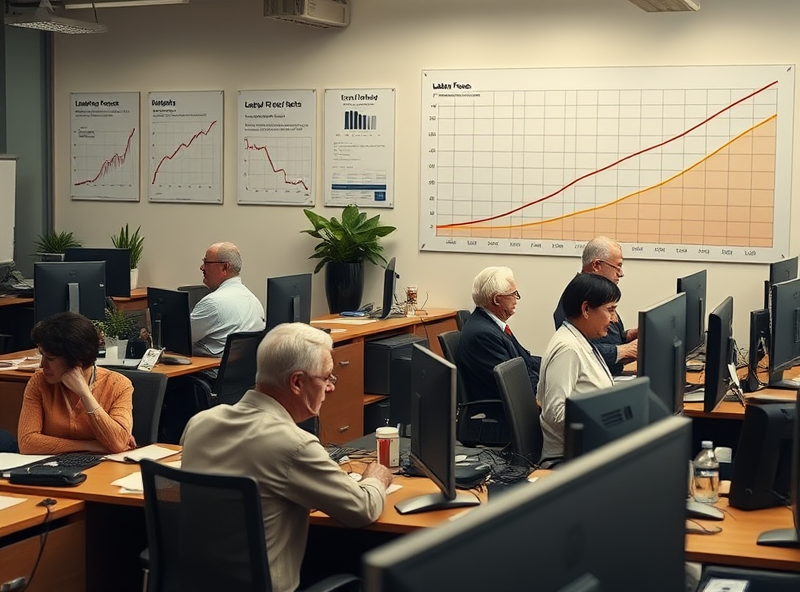
Global Economic Impact of Population Aging

Hello, thoughtful readers! Have you noticed how the world’s population is changing? It’s a quiet revolution happening right before our eyes: people are living longer, and in many parts of the world, birth rates are lower than they used to be. This global phenomenon is known as population aging, and it means that the proportion of older people in our societies is growing significantly. While living longer is a wonderful achievement, this demographic shift has profound implications that reach far beyond just social structures; it’s having, and will continue to have, a massive impact on economies around the world. You might wonder, “How does having more older people affect things like jobs, economic growth, or even government budgets?” or “Are the economic impacts the same everywhere?” You’re asking questions that are central to understanding the future of the global economy! The purpose of this article is to explore the significant economic impacts of population aging on a global scale, examining both the challenges and the potential opportunities it presents. Let’s delve into how this fundamental demographic shift is reshaping the economic landscape and what it means for countries, businesses, and individuals.
Understanding the Global Shift Towards Aging
Population aging is a trend affecting nearly every country, though at different speeds and stages. It’s primarily driven by two factors: increasing life expectancy and decreasing fertility rates. Advances in healthcare, nutrition, sanitation, and living standards mean that more people are living longer, healthier lives than ever before. At the same time, in many countries, families are having fewer children. When these two trends occur together, the result is a population where the proportion of older individuals grows relative to younger ones. This isn’t just a phenomenon in wealthy, developed nations; many emerging economies are also experiencing rapid population aging, sometimes even faster than countries that aged earlier. This means that the economic impacts of aging are becoming a universal concern, requiring attention and adaptation worldwide.
Impact on the Labor Force: Fewer Workers, Different Skills
One of the most direct and significant economic impacts of population aging is on the labor force. As the proportion of older people increases and birth rates remain low, the share of the population that is of traditional working age (roughly 15-64) tends to shrink relative to the total population. This can lead to a slower-growing or even declining workforce. A smaller workforce can potentially constrain economic growth, as there are fewer people producing goods and services. It can also lead to labor shortages in certain industries or sectors. Furthermore, an aging workforce means a larger proportion of older, potentially less physically able workers, and a smaller proportion of younger workers entering the labor market with newer skills or different perspectives. This shift requires economies to think about how to maintain productivity with fewer workers and how to leverage the experience and skills of older workers. Encouraging later retirement, increasing labor force participation among women and other underrepresented groups, and potentially managing immigration policies become crucial strategies for maintaining a sufficient workforce.
Impact on Economic Growth: A Potential Slowdown
The impact on the labor force directly ties into the potential impact on overall economic growth, often measured by Gross Domestic Product (GDP). Economic growth is fundamentally driven by increases in the labor force, capital investment, and productivity (how efficiently labor and capital are used). With a slower-growing or shrinking workforce, one of the key engines of growth is naturally constrained. Studies have shown a correlation between population aging and slower per capita GDP growth. As the ratio of retirees to workers increases (the old-age dependency ratio), there are fewer workers supporting a larger number of non-working elderly. This can reduce the overall productive capacity of the economy. To counteract this potential slowdown, economies need to focus intensely on boosting productivity through technological innovation, improving education and skills, and increasing capital investment. Essentially, each worker needs to become more productive to maintain the same level of overall economic output growth.
Impact on Consumption and Savings Patterns
Population aging also influences aggregate consumption and savings patterns in an economy. Older individuals typically have different spending habits than younger ones. While overall consumption might decrease as people retire and their incomes change, spending on certain categories, particularly healthcare, tends to increase significantly with age. This shift in demand can impact different industries – potentially boosting the healthcare, pharmaceutical, and elder care sectors, while perhaps reducing demand for goods and services primarily consumed by younger populations. Savings patterns also change over a lifetime. People typically save more during their peak earning years to prepare for retirement. As they enter retirement, they begin to draw down their savings. The net effect of a larger elderly population on national savings rates is complex and debated, depending on factors like retirement systems, healthcare costs, and cultural savings habits. Changes in aggregate savings can influence the availability of capital for investment, which in turn affects economic growth.
Impact on Public Finances: Strained Budgets
One of the most significant and widely discussed economic impacts of population aging is the strain it places on public finances. Governments in most developed countries, and increasingly in emerging economies, face rising expenditures related to pensions (Social Security in the U.S.) and healthcare for their aging populations. As the number of retirees grows relative to the number of working individuals contributing taxes, the financial sustainability of pay-as-you-go pension systems and public healthcare programs comes under pressure. Governments may face difficult choices: raising taxes, cutting benefits, increasing retirement ages, or borrowing more. This fiscal challenge is a major concern for policymakers worldwide. It requires reforms to pension and healthcare systems to ensure their long-term viability and finding ways to increase government revenues or control spending in other areas. The size of this challenge varies depending on the generosity of a country’s social welfare programs and the speed of its population aging.
Impact on Innovation and Productivity Growth
The effect of population aging on innovation and productivity growth is a complex area of study. On one hand, an older workforce might be perceived as less adaptable to new technologies or less entrepreneurial than a younger one, potentially slowing down the rate of innovation. Some research suggests that aging populations can lead to lower rates of entrepreneurship and reduced labor mobility, which can hinder economic dynamism. On the other hand, older workers bring valuable experience, knowledge, and mentorship to the workforce. Their accumulated wisdom can be crucial for problem-solving and training younger generations. Furthermore, the challenges posed by aging itself (e.g., healthcare needs, elder care services) can spur innovation in new industries and technologies aimed at serving older populations. Investing in lifelong learning and ensuring that older workers have opportunities to update their skills are important for maintaining productivity in an aging workforce. The net impact on innovation and productivity depends heavily on how well societies adapt and leverage the potential of their older populations.
Impact on Financial Markets and Investment
Population aging also influences financial markets and investment patterns. As individuals approach and enter retirement, their investment strategies often shift from growth-oriented assets (like stocks) to more conservative, income-generating assets (like bonds). This demographic shift in investment preferences can influence demand for different types of financial assets. Furthermore, changes in national savings rates, influenced by the balance of working and retired populations, can affect the overall pool of capital available for investment in the economy. A potential decline in national savings could lead to higher borrowing costs for businesses and governments, impacting investment levels. The increasing demand for retirement income also puts pressure on pension funds and investment managers to generate stable returns over long periods. The growth of the elderly population also creates investment opportunities in industries that cater to their needs, such as healthcare, pharmaceuticals, senior living facilities, and financial services focused on retirement planning.
Regional Variations in the Aging Impact
While population aging is a global trend, its economic impact varies significantly depending on a country’s stage of development and the speed of its demographic transition. Developed countries, which have been aging for longer and often have established social welfare systems, face significant challenges related to the fiscal sustainability of pensions and healthcare. However, they also often have higher levels of wealth and more mature financial markets to help manage these challenges. Emerging economies, on the other hand, are often aging much faster than developed countries did at a similar stage of development. This means they may face the challenges of aging (like increased healthcare costs) before they have built up the same level of wealth or established comprehensive social safety nets. However, some emerging economies still have relatively young populations compared to the oldest developed nations, potentially giving them a demographic window to implement reforms and prepare for future aging. The specific economic structure and policy responses of each country will determine how effectively it navigates the impacts of aging.
Strategies for Navigating the Aging Economy
Addressing the economic impacts of population aging requires proactive and multi-faceted strategies. No single solution will suffice, and the specific mix of policies will vary by country. Potential strategies include:
- Increasing Labor Force Participation: Encouraging people to work longer by raising retirement ages, removing disincentives to work in pension systems, and creating flexible work arrangements for older workers. Increasing participation among women and other groups.
- Boosting Productivity: Investing in education and skills training (including for older workers), promoting technological innovation, and encouraging capital investment to ensure that economic output can grow even with a slower-growing workforce.
- Reforming Pension and Healthcare Systems: Adjusting retirement ages, modifying benefit formulas, exploring ways to control healthcare costs, and ensuring the financial sustainability of these crucial social programs.
- Promoting Healthy Aging: Investing in public health initiatives and preventive care to help people stay healthier for longer, reducing healthcare costs in later life and enabling longer working lives.
- Facilitating Immigration: For countries with declining populations, managed immigration can help supplement the workforce and contribute to economic growth, although this is often a politically sensitive issue.
- Encouraging Savings: Implementing policies that encourage individuals to save more for their own retirement to reduce reliance on public systems.
- Developing the “Silver Economy”: Recognizing the economic opportunities presented by the needs and demands of older consumers and investing in industries that cater to this growing demographic (e.g., elder care, specialized housing, assistive technologies).
Implementing these strategies effectively requires long-term planning, political will, and cooperation across different sectors of society.
Population Aging: A Challenge and an Opportunity
In conclusion, population aging is a fundamental global demographic trend with profound and complex economic impacts. It affects the size and composition of the labor force, influences economic growth rates, shifts consumption and savings patterns, strains public finances, and presents challenges and opportunities for innovation and financial markets. While the challenges, particularly related to labor supply and public finances, are significant, they are not insurmountable. By understanding these impacts and implementing proactive strategies – such as encouraging longer working lives, boosting productivity, reforming social systems, and investing in health and education – countries can navigate the aging process more effectively. Population aging is not just a burden; it also represents an achievement of longer lives and creates new economic opportunities in sectors serving older populations. By adapting our economic structures and policies, we can work towards building resilient, prosperous, and inclusive economies that can thrive even with changing demographics. Staying informed about these trends is crucial for understanding the economic future we are all a part of. Wishing you insight and foresight as you consider the global economic landscape! 😊







